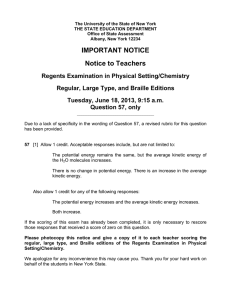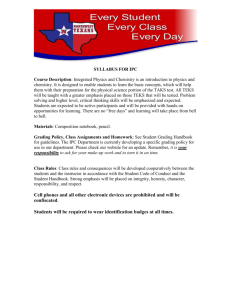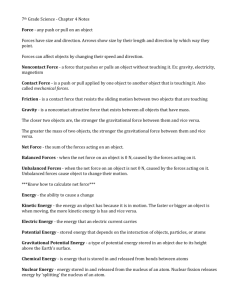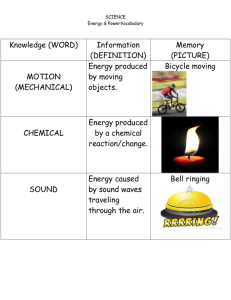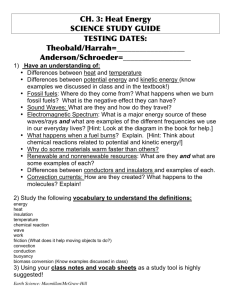After your registration is complete and your proctor has been... by Examination for IPC 1B. To the Student:
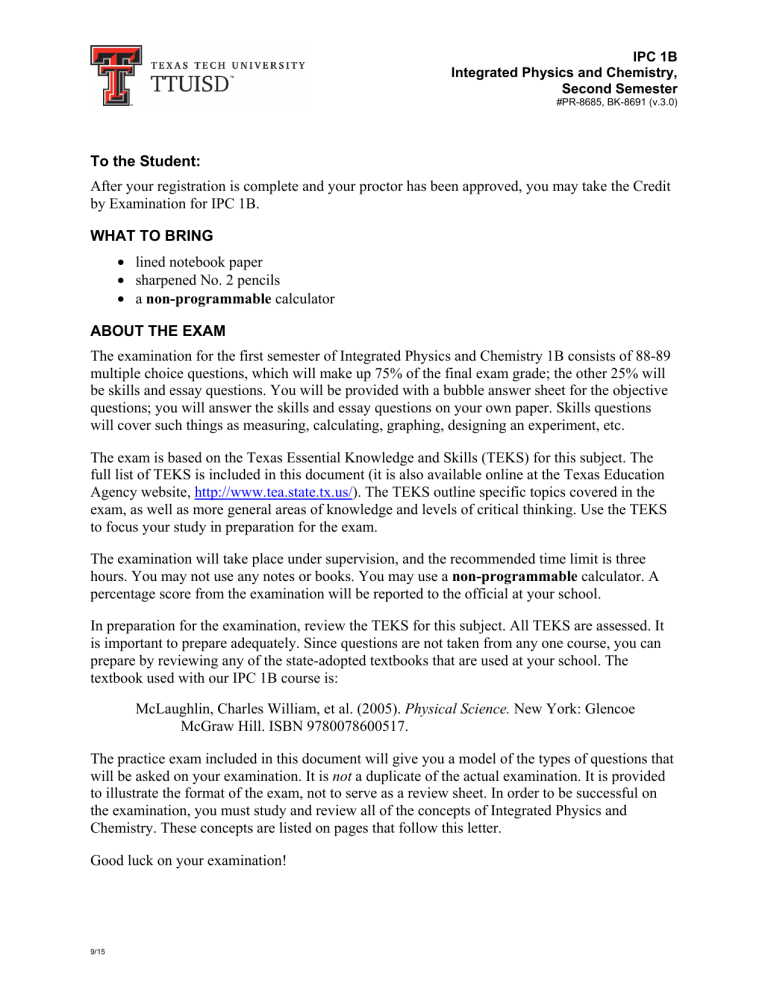
IPC 1B
Integrated Physics and Chemistry,
Second Semester
#PR-8685, BK-8691 (v.3.0)
To the Student:
After your registration is complete and your proctor has been approved, you may take the Credit by Examination for IPC 1B.
WHAT TO BRING
• lined notebook paper
• sharpened No. 2 pencils
• a calculator
ABOUT THE EXAM
The examination for the first semester of Integrated Physics and Chemistry 1B consists of 88-89 multiple choice questions, which will make up 75% of the final exam grade; the other 25% will be skills and essay questions. You will be provided with a bubble answer sheet for the objective questions; you will answer the skills and essay questions on your own paper. Skills questions will cover such things as measuring, calculating, graphing, designing an experiment, etc.
The exam is based on the Texas Essential Knowledge and Skills (TEKS) for this subject. The full list of TEKS is included in this document (it is also available online at the Texas Education
Agency website, http://www.tea.state.tx.us/ ). The TEKS outline specific topics covered in the exam, as well as more general areas of knowledge and levels of critical thinking. Use the TEKS to focus your study in preparation for the exam.
The examination will take place under supervision, and the recommended time limit is three hours. You may not use any notes or books. You may use a non-programmable calculator. A percentage score from the examination will be reported to the official at your school.
In preparation for the examination, review the TEKS for this subject. All TEKS are assessed. It is important to prepare adequately. Since questions are not taken from any one course, you can prepare by reviewing any of the state-adopted textbooks that are used at your school. The textbook used with our IPC 1B course is:
McLaughlin, Charles William, et al. (2005). Physical Science.
New York: Glencoe
McGraw Hill. ISBN 9780078600517.
The practice exam included in this document will give you a model of the types of questions that will be asked on your examination. It is not a duplicate of the actual examination. It is provided to illustrate the format of the exam, not to serve as a review sheet. In order to be successful on the examination, you must study and review all of the concepts of Integrated Physics and
Chemistry. These concepts are listed on pages that follow this letter.
Good luck on your examination!
9/15
IPC 1B CBE—Study Sheet
Before taking this exam, you should be able to:
• define and calculate speed, momentum, acceleration, work, and power in systems;
• understand and apply Newton’s laws of gravity, and Bernoulli’s, Archimedes’, and
Pascal’s principles;
• analyze and calculate the effects of changing force or distance in simple machines;
• understand and calculate mechanical advantage, efficiency of levers, motors, wheels and axles, pulleys, and ramps;
• understand and calculate the law of conservation of energy and explain transitions from potential to kinetic energy;
• understand and calculate heat, temperature, transfer of heat energy, and heating and cooling systems;
• understand similarities and differences of static electricity and current electricity;
• compare series and parallel circuits;
• understand and calculate current, voltage, and resistance of electrical circuits;
• understand and calculate electric power and energy;
• describe how transformers work;
• analyze relationships between electricity and magnetism;
• identify wave types and characteristics, wave interactions-interference, polarization, reflection, refraction, and resonance as pertaining to waves in water, sound, and light;
• identify uses of electromagnetic waves;
• demonstrate the ability to design a scientific investigation and report data as charts, tables, and graphs.
2
IPC 1B Practice Exam
The following practice exam will help prepare you for the CBE. The questions are similar to those on the CBE, though not identical, and the format is similar. The practice exam is presented to help you study for the CBE. Work straight through the practice exam as if you were actually taking the proctored test. When you encounter a question you don’t know at all or a topic that isn’t fresh in your memory, mark that question so that you will know to go back and study the topic more thoroughly.
Formula Bank
The following formulas are covered in the scope of this course. Although you will not be required to use them all, your knowledge of these formulas will help you in reasoning through many of the questions on this exam.
D = m/v F/A
V = l × w × h F × d
A = l × w W/t s = d/t d = v × t
GPE = weight × height
KE =
2
2
MA = R/E H = m × Δ T × s.h.
momentum = m × g I × R
F = m × a V × I
W = m × g P × t v = λ × f
Multiple Choice
Circle the letter of the response that best answers the question or completes the statement.
1. The law of conservation of energy states that
A. energy can be gained but not lost.
B. energy can be lost but not gained.
C. energy cannot be lost or gained.
D. kinetic energy is conserved, but potential energy is not.
3
2. A distance-time graph for acceleration is always a __________ line. straight crooked
3. Which of the following is accelerating?
A. A car traveling 33 km/hr slows to 25 km/hr.
B. A car traveling 33 km/hr speeds up to 42 km/hr.
C. A car traveling 35 km/hr due north turns east while still traveling 35 km/hr.
D. All of the above.
4. A bus leaves at 9 a.m. with a group of tourists. They travel 350 km before stopping for lunch. Then they travel an additional 250 km until the end of their trip at 3 p.m. What was the average speed of the bus?
75
C.
D. km/h
5. A change of position relative to some reference point is speed. velocity.
6. Balanced forces cause
A. a moving particle to slow down.
B. a moving particle to speed up.
C. no change in motion.
D. a change in direction.
7. One newton equals one kg.
B.
C. m/sec.
D. m/sec/sec.
8. A newton in SI is most like which unit in the system of measurement used in the United
States? watt pound
4
9. The attractive force between all objects in the universe is called inertia. gravity.
D. a push or a pull.
A. is a push or a pull.
B. gives energy to an object.
C. can cause an object to change its motion.
D. can do all of the above.
11. An astronaut with a mass of 80 kg experiences weightlessness when she is in space. What will her weight be when she returns to Earth?
C. kg
D. N
12. Two balls are dropped from the top of a ladder. They are both the same size, but one is very light and the other is very heavy. Which ball will hit the floor first?
A.
B. the lighter ball
C. Both will hit at the same time.
D. Not enough information is given to determine the answer.
13. The relationship between buoyant force and weight of displaced fluid was stated by
Newton.
C.
14. Compared with the slow-moving water along the edge of a river, the rapidly-moving stream in the middle exerts __________ pressure. more
D.
15. In order for a submarine to float, the density of the ocean water must be
A. greater than the density of the submarine.
B. less than the density of the submarine.
C. equal to or greater than the density of the submarine.
D. The density of the submarine is not related to either mass or volume.
5
16. In a hydraulic system, the pressure of the fluid in the system is
A. the same throughout the system.
B. greater in the smaller piston.
D. multiplied in the larger piston.
17. Which of the following would cause an increase in pressure?
A. increasing the area without changing force
B. decreasing the area without changing force
C. decreasing the force without changing area
D. decreasing both force and area by the same amount
18. An example of work being done is
A. a child lifting a doll.
B. a person pushing against a locked door.
C. a person sitting beside an assembly line, checking the quality of glass bottles passing by.
D. All of the above.
19. Sharpening wedge
A. decreases the mechanical advantage.
B. increases the effort force.
C. decreases the mechanical advantage and increases the effort force.
D. increases the mechanical advantage and decreases the effort force.
20. In a second-class lever, the resistance is between the fulcrum and the effort force.
Which of the following is a second-class lever?
A. a screwdriver used to open a can of paint
B.
C. a pair of scissors
D. a broom handle
21. A wedge is a moving
A. wheel and axle. lever.
22. Because of __________, no machine has 100% efficiency.
B. an increase in distance friction
D. None of the above
6
23. Energy is defined as
A.
B. the ability to produce heat.
C. a change in motion.
D. the ability to do work or cause change.
24. Visitors at an amusement park can plunge from a 20-m tower, attached to a bungee cord.
A guest standing at the top of the tower has __________ energy. gravitational chemical
25. The amusement-park bungee jumper leaps from the tower, pulling the bungee cord taut at the bottom of his plunge and then bouncing back upward. What form of energy is being stored as he plunges downward?
A.
B. gravitational potential energy
D. elastic potential energy
26. Kinetic energy depends upon
C. mass and velocity. position. is transferred
A. from cold to hot.
B.
28. An example of a good conductor is wood. plastic.
29. A temperature of 15°C is the same as
0
B.
D. K.
7
30. The specific heat of a substance is the
A. amount of heat needed to raise the temperature of 1 g of the substance from its melting point to its boiling point.
B. number of calories needed to raise the temperature of 1 g of the substance 1°C. caloric of the substance.
D. kinetic energy of the substance.
31. If it takes 1 cal of heat to raise the temperature of 1 g of water 1°C, the specific heat of water is
1
B.
32. In which stroke of an internal combustion engine does a spark plug ignite the fuel-air mixture? compression
C.
33. Insulation materials reduce heat loss because they
C. block out the sun.
D.
34. Active and passive heating are two types of __________ heating systems. hot-water solar
35. When a neutral object gains electrons,
A. its overall charge is positive.
B. its overall charge is negative.
C. it stays neutral.
D. it loses as many protons as it has gained electrons. is produced by conduction. insulation.
8
37. Electrons are described as stationary
B.
38. A good electrical conductor is glass. wood.
39. A circuit is in series if
A. different parts are on separate branches.
B. electrons may take several paths.
C. electrons have only one path at all times.
D. only one circuit is open and the other branches are closed.
40. As a positively charged object touches the knob of an uncharged electroscope,
A. the positive charges are transferred to the knob.
B. the positive charges are transferred to the leaves.
C. free electrons from the knob and leaves are attracted to the object.
D. the leaves become negatively charged.
41. Magnetic domains are groups of aligned magnetic fields of atoms. neutrons.
42. The ends of a bar magnet are called the cores. poles.
43. An electromagnet is weakened by
A. increasing the number of loops.
B. decreasing the current.
D. using an iron core.
9
44. What happens to magnetic force as the distance between two magnetic poles decreases?
A. It remains constant.
B.
D. It first increases and then decreases as they draw nearer.
45. Which of the following devices contains an electromagnet?
B. speakers of a sound system
C.
D. All of the above
46. Before electricity can come from the high voltage wires that travel from a power plant into a city, the voltage must be reduced from 2,400 V to 120 V. If the primary coil has
500 turns of wire, how many turns are on the secondary coil?
25
50
47. If a wire carrying current is twisted into loops, the strength of its magnetic field is
B.
C. is not affected.
D. increases and then decreases.
48. Energy traveling through matter may be
A. a series of waves.
B. a disturbance along the surface of that matter.
C. transferred from one part to another.
D. All of the above.
49. In a transverse wave, a trough is __________ of particles of the medium.
A. displacement
B. any maximum displacement
C. a maximum displacement downward
D. a maximum displacement upward
A. are both transverse and longitudinal.
B. transfer energy through a medium.
C. move at right angles to the medium.
D. move parallel to the medium.
10
51. If you read “60 Hz,” you know that means
A. waves are 60 mm long.
B. 60 waves pass a given point each second.
C. waves have an amplitude of 60 mm.
D. waves travel at 60 lambda/sec.
52. If you reach your hand into an aquarium, you may notice that your arm looks bent or broken. This is because of a phenomenon called reflection. diffraction.
53. Sound travels as a
A. series of compressions and rarefactions.
B. series of compressions only.
C. series of up-and-down vibrations.
D. wave without a medium.
54. Which of the following materials would transmit sound most quickly? oil iron
55. Sounds above how many dB may cause permanent hearing damage in humans?
20
120
56. Sounds with intensities great enough to damage human hearing might be generated by
B. amplification systems at rock concerts.
C. jackhammers and other machines at construction sites.
D. All of the above.
57. High pitch is produced by sound waves that have
C. frequencies.
D. frequencies.
11
58. The property of sound that increases when sounds get louder is frequency. pitch.
59. The Doppler effect may be generated when
A. the source of sound and the observer move away from each other.
B. an observer moves toward the source of sound.
C. an observer moves away from the source of sound.
D. All of the above.
60. Examples of waves that travel in vacuums are __________ waves. light sound
A. cannot be seen.
B. are felt as heat.
C. have lower frequencies than visible red light.
D. All of the above.
62. The electromagnetic spectrum does not include gamma
B.
63. A person waiting to see a grand parade may hear the sounds of a band coming even before the band turns the corner to march along the street the watcher is on, but the sound is not very clear. This effect is described as reflection. refraction. continued →
12
Written Response
Answer the following questions on your own paper in complete sentences. Show all work, including units, cancellations, etc. Partial credit may be given even if the final answer is incorrect, as long as your work is shown.
64. People living at the Earth’s equator are traveling at a speed of about 1,670 km/hr as the
Earth spins on its axis. Explain why these people do not feel themselves moving at this rapid speed.
65. Describe how a submarine rises and falls in the ocean. Be sure you demonstrate an understanding of the physical property involved and name the scientist credited with discovering and describing that property.
66. At a lake, a large number of dead fish are washed up on the shore near a pipe that is pouring forth water from a nearby electric plant. Explain why the fish died and how to correct the problem.
67. Draw a transverse wave. Label the following: crest, trough, wavelength, and amplitude .
68. Describe energy conversions that take place as a person jumps on a trampoline.
13
10. D
11. D
12. C
13. A
14. A
15. C
16. A
IPC 1B Practice Exam Answer Key
Multiple Choice
17. B
18. A
19. B
20. B
21. D
22. C
23. D
24. B
25. D
26. C
27. A
28. B
29. D
30. B
31. A
32. C
33. A
34. C
35. B
36. B
37. B
38. A
39. C
40. C
41. A
42. D
43. B
44. C
45. D
46. B
47. A
48. D
14
49. C
50. B
51. B
52. A
53. A
54. C
55. D
56. D
57. C
58. C
59. D
60. A
61. D
62. D
63. C continued →
Written Response
64. People use objects around them to judge motion. If you are seated at a desk studying, that desk, the walls, and the furnishings around you are all traveling at the same rate as you are. Therefore, you do not perceive motion. The same is true of those who live near the equator. They are traveling at 1,670 km/hr and their surroundings are traveling at 1,670 km/hr. Therefore, they do not perceive rotational motion.
65. For a submarine to move downward in the ocean, its density must be greater than that of the ocean water. The buoyant force of water pushing upward must be greater than the downward force gravity exerts on the sub. So, a submarine takes water into large tanks to serve as ballast to help it submerge, and reverses the process to rise. For the submarine to float suspended without moving up or down, the buoyant force of the water must equal the gravitational force acting on the sub. The credit for being the first to discover this relationship goes to Archimedes, who recognized that the buoyant force acting on an object is equal to the weight of the fluid displaced.
66. The fish probably died because of thermal pollution. Just as a car uses water and coolant to cool its engine, the electric plant may use water to cool down its equipment. In years past, that warm water was dumped into nearby lakes. Fish can tolerate only a certain range of temperature variation in their environment, and, if that range is exceeded, the fish will die. Power plants now cool the water before they dump it in nearby bodies of water.
67.
68. As a person lands on a trampoline, elastic energy is stored in the stretched trampoline.
The elastic energy is converted to kinetic energy (energy of motion) as the jumper flies upward. Then, at the top of the jump, the kinetic energy has been converted to gravitational potential energy which is converted back into kinetic energy as the jumper falls downward, and then the kinetic energy is briefly stored in the trampoline once again as elastic potential energy.
15
Texas Essential Knowledge and Skills
IPC 1 – Integrated Physics and Chemistry
§112.38. Integrated Physics and Chemistry, Beginning with School Year 2010-2011 (One Credit).
(a) General requirements. Students shall be awarded one credit for successful completion of this course. Prerequisites: none. This course is recommended for students in Grade 9 or 10.
(b) Introduction.
(1) Integrated Physics and Chemistry. In Integrated Physics and Chemistry, students conduct laboratory and field investigations, use scientific methods during investigation, and make informed decisions using critical thinking and scientific problem solving. This course integrates the disciplines of physics and chemistry in the following topics: force, motion, energy, and matter.
(2) Nature of science. Science, as defined by the National Academy of Sciences, is the "use of evidence to construct testable explanations and predictions of natural phenomena, as well as the knowledge generated through this process." This vast body of changing and increasing knowledge is described by physical, mathematical, and conceptual models. Students should know that some questions are outside the realm of science because they deal with phenomena that are not scientifically testable.
(3) Scientific inquiry. Scientific inquiry is the planned and deliberate investigation of the natural world. Scientific methods of investigation are experimental, descriptive, or comparative. The method chosen should be appropriate to the question being asked.
(4) Science and social ethics. Scientific decision making is a way of answering questions about the natural world. Students should be able to distinguish between scientific decision-making methods (scientific methods) and ethical and social decisions that involve science (the application of scientific information).
(5) Science, systems, and models. A system is a collection of cycles, structures, and processes that interact. All systems have basic properties that can be described in space, time, energy, and matter. Change and constancy occur in systems as patterns and can be observed, measured, and modeled. These patterns help to make predictions that can be scientifically tested. Students should analyze a system in terms of its components and how these components relate to each other, to the whole, and to the external environment.
(c) Knowledge and skills.
(1) Scientific processes.
The student, for at least 40% of instructional time, conducts laboratory and field investigations using safe, environmentally appropriate, and ethical practices. The student is expected to:
(A) demonstrate safe practices during laboratory and field investigations; and
(B) demonstrate an understanding of the use and conservation of resources and the proper disposal or recycling of materials.
(2) Scientific processes.
The student uses scientific methods during laboratory and field investigations. The student is expected to:
(A) know the definition of science and understand that it has limitations, as specified in subsection (b)(2) of this section;
(B) plan and implement investigative procedures, including asking questions, formulating testable hypotheses, and selecting equipment and technology;
(C) collect data and make measurements with precision;
(D) organize, analyze, evaluate, make inferences, and predict trends from data; and
(E) communicate valid conclusions.
(3) Scientific processes.
The student uses critical thinking, scientific reasoning, and problem solving to make informed decisions. The student is expected to:
(A) in all fields of science, analyze, evaluate, and critique scientific explanations by using empirical evidence, logical reasoning, and experimental and observational testing, including examining all sides of scientific evidence of those scientific explanations, so as to encourage critical thinking by the student;
(B) communicate and apply scientific information extracted from various sources such as current events, news reports, published journal articles, and marketing materials;
(C) draw inferences based on data related to promotional materials for products and services;
(D) evaluate the impact of research on scientific thought, society, and the environment;
(E) describe connections between physics and chemistry and future careers; and
(F) research and describe the history of physics and chemistry and contributions of scientists.
(4) Science concepts.
The student knows concepts of force and motion evident in everyday life. The student is expected to:
(A) describe and calculate an object's motion in terms of position, displacement, speed, and acceleration;
(B) measure and graph distance and speed as a function of time using moving toys;
16
(C) investigate how an object's motion changes only when a net force is applied, including activities and equipment such as toy cars, vehicle restraints, sports activities, and classroom objects;
(D) assess the relationship between force, mass, and acceleration, noting the relationship is independent of the nature of the force, using equipment such as dynamic carts, moving toys, vehicles, and falling objects;
(E) apply the concept of conservation of momentum using action and reaction forces such as students on skateboards;
(F) describe the gravitational attraction between objects of different masses at different distances, including satellites; and
(G) examine electrical force as a universal force between any two charged objects and compare the relative strength of the electrical force and gravitational force.
(5) Science concepts.
The student recognizes multiple forms of energy and knows the impact of energy transfer and energy conservation in everyday life. The student is expected to:
(A) recognize and demonstrate that objects and substances in motion have kinetic energy such as vibration of atoms, water flowing down a stream moving pebbles, and bowling balls knocking down pins;
(B) demonstrate common forms of potential energy, including gravitational, elastic, and chemical, such as a ball on an inclined plane, springs, and batteries;
(C) demonstrate that moving electric charges produce magnetic forces and moving magnets produce electric forces;
(D) investigate the law of conservation of energy;
(E) investigate and demonstrate the movement of thermal energy through solids, liquids, and gases by convection, conduction, and radiation such as in weather, living, and mechanical systems;
(F) evaluate the transfer of electrical energy in series and parallel circuits and conductive materials;
(G) explore the characteristics and behaviors of energy transferred by waves, including acoustic, seismic, light, and waves on water as they superpose on one another, bend around corners, reflect off surfaces, are absorbed by materials, and change direction when entering new materials;
(H) analyze energy conversions such as those from radiant, nuclear, and geothermal sources; fossil fuels such as coal, gas, oil; and the movement of water or wind; and
(I) critique the advantages and disadvantages of various energy sources and their impact on society and the environment.
(6) Science concepts.
The student knows that relationships exist between the structure and properties of matter. The student is expected to:
(A) examine differences in physical properties of solids, liquids, and gases as explained by the arrangement and motion of atoms, ions, or molecules of the substances and the strength of the forces of attraction between those particles;
(B) relate chemical properties of substances to the arrangement of their atoms or molecules;
(C) analyze physical and chemical properties of elements and compounds such as color, density, viscosity, buoyancy, boiling point, freezing point, conductivity, and reactivity;
(D) relate the physical and chemical behavior of an element, including bonding and classification, to its placement on the Periodic Table; and
(E) relate the structure of water to its function as a solvent and investigate the properties of solutions and factors affecting gas and solid solubility, including nature of solute, temperature, pressure, pH, and concentration.
(7) Science concepts.
The student knows that changes in matter affect everyday life. The student is expected to:
(A) investigate changes of state as it relates to the arrangement of particles of matter and energy transfer;
(B) recognize that chemical changes can occur when substances react to form different substances and that these interactions are largely determined by the valence electrons;
(C) demonstrate that mass is conserved when substances undergo chemical change and that the number and kind of atoms are the same in the reactants and products;
(D) analyze energy changes that accompany chemical reactions such as those occurring in heat packs, cold packs, and glow sticks and classify them as exothermic or endothermic reactions;
(E) describe types of nuclear reactions such as fission and fusion and their roles in applications such as medicine and energy production; and
(F) research and describe the environmental and economic impact of the end-products of chemical reactions such as those that may result in acid rain, degradation of water and air quality, and ozone depletion.
Source: The provisions of this §112.38 adopted to be effective August 4, 2009, 34 TexReg 5063.
17
